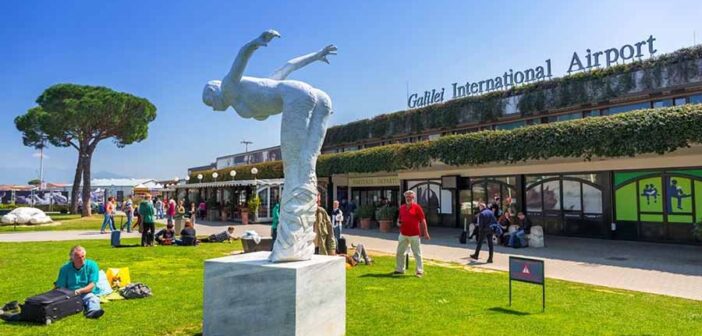Pisa International Airport, also known as Galileo Galilei Airport, located just 1 kilometre from Pisa’s city centre, serves as a welcoming gateway to Tuscany, handling around 5.5 million passengers annually. This compact airport, a hub for low-cost carriers like Ryanair and easyJet, connects travellers to 84 destinations across 27 countries, offering a straightforward experience for those exploring the Leaning Tower or connecting to cities like London and Barcelona.
Accessing the airport is remarkably easy due to its proximity to the city. The PisaMover, an automated shuttle train, links the airport to Pisa Centrale railway station in just 5–8 minutes, operating from 6:00 AM to midnight (1:00 AM in summer) with fares at €5.
Taxis outside the arrivals hall cost €10–€15 for a 5–10-minute ride to central Pisa, while the E3 bus serves local routes for €2.50. Drivers can access the airport via the A12 motorway, with five parking lots offering 3,000 spaces, including free parking for passengers with reduced mobility. A covered walkway connects the terminal to the train station, making transfers seamless even with luggage.
The airport’s single terminal, spanning two levels, is designed for simplicity. With 33 check-in desks and 16 gates, it handles both Schengen and non-Schengen flights, with Schengen gates on the ground floor and non-Schengen gates upstairs. Clear signage and a compact layout ensure easy navigation, though peak summer periods can lead to overcrowding. Passengers are advised to arrive two hours early for domestic flights and three hours for international ones to manage security and check-in queues, which can extend due to high traffic from carriers like Ryanair and Wizz Air. A viewing terrace near Gate 6 offers a spot for plane enthusiasts to watch take-offs and landings.
Dining and retail options are practical for a smaller airport. Over ten eateries, including Trattoria Toscana for authentic Italian dishes and Caffè Siesta for quick espressos, operate from early morning until the last flight. The duty-free shop in the departures area stocks Tuscan olive oil, wines, and souvenirs, alongside perfumes and cosmetics. Convenience stores provide travel essentials, though some travellers note high prices, such as €7.50 for small items. Most dining and retail outlets are airside, so passengers should plan purchases after security.
Facilities cater to essential needs with a focus on accessibility. Free Wi-Fi is available but time-limited, and printing services are offered for a fee at Europe Rent WiFi near arrivals. The Galilei VIP Lounge and VIP Club Lounge, open daily from 6:00 AM to 10:00 PM, provide snacks, drinks, and newspapers for €15–€25. Passengers with reduced mobility benefit from ramps, adapted toilets, and ambulifts, with assistance bookable 48 hours in advance. A family room near the ticket office includes baby-changing facilities, and a health station, pharmacy, and chapel are available. However, luggage storage is limited, with off-site options at Pisa Centrale. A tourist information desk outside arrivals assists with local travel and hotel bookings.
On-time performance is generally reliable, with real-time updates available via the airport’s website, Flightradar24, or in-terminal displays. The airport operates around 100 daily flights, with Friday being the busiest day. Delays can occur during peak seasons due to insufficient gate space or ground handling equipment, as some travellers report waiting on aircraft for up to an hour. Major airlines include Aer Lingus, BA, and Transavia, serving routes to Dublin, Paris, and Málaga.
Connections are straightforward for single-ticket passengers, with minimum connection times of 60 minutes for all flight types. Baggage is typically transferred automatically, and the single terminal eliminates the need for inter-terminal transfers. Separate-ticket travellers should allow extra time for baggage reclaim and re-check-in. The airport’s focus on low-cost routes means fewer hub connections, but its layout supports quick gate access.
Potential delays often stem from overcrowding, particularly at security and passport control, where limited staffing—sometimes only two desks—can cause backups. The lack of air conditioning in ground-floor gate areas can make waiting uncomfortable in summer, and travellers have noted rude staff or disorganised processes during busy periods. Technical issues, such as insufficient stairs for aircraft or ground generator shortages, can also delay disembarking. Checking flight status and using the Fast Track service for €5 can help mitigate delays.Pisa International Airport offers a functional and accessible experience for travellers. Its proximity to the city, clear layout, and practical amenities make it a solid choice for exploring Tuscany or catching low-cost flights across Europe.




